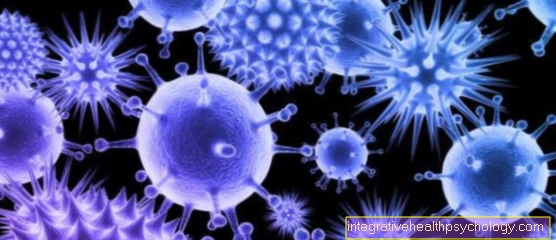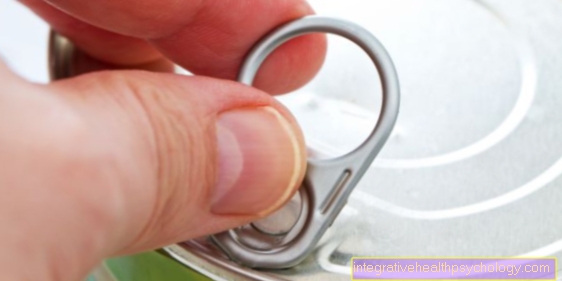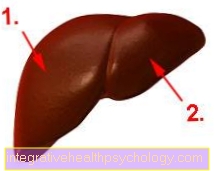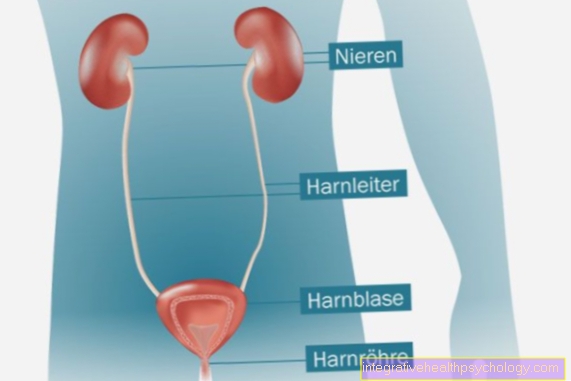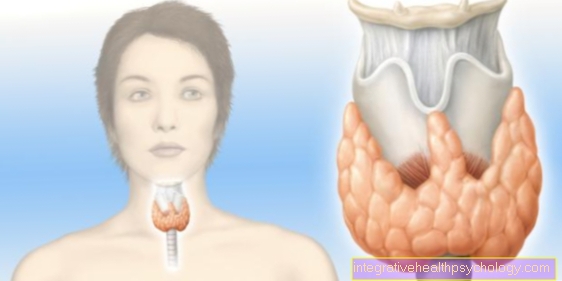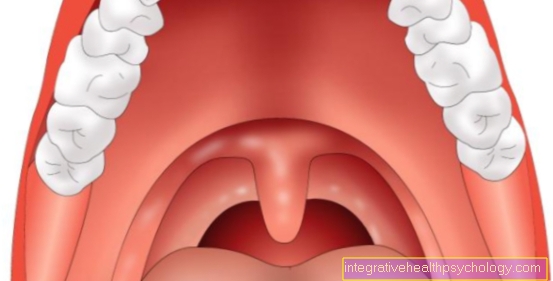Pregnancy process
Synonyms in a broader sense
Gestation, pregnancy
English: pregnancy
Meaning of the word: gravitas (lat., Heaviness), swangar (old high German, cumbersome / difficult)

How long does a pregnancy last?
The duration of a pregnancy is usually counted from the first day of the last normal menstrual bleeding, because the exact time of fertilization - i.e. when the sperm and egg cell fuse together - often cannot be precisely determined.
If pregnancy is calculated from the day of fertilization or conception, this is called post conceptionem (p.c) in Latin.
It usually takes 40 weeks from the first day of your last menstrual bleeding to delivery. Pregnancy is divided into three thirds of pregnancy, also called trimesters.
- The first trimester of pregnancy includes the first to third month or months of pregnancy first to twelfth week of pregnancy (SSW).
- The second trimester describes the fourth to sixth month of pregnancy or the 13th to 28th week of pregnancy.
- The third trimester of pregnancy includes the seventh to ninth month and / or month of pregnancy 29th to 40th week of pregnancy.
The current gestation period is usually in Number of weeks and days of pregnancy specified. For example, if the length of pregnancy is specified as 22 + 4, the expectant mother is 22 weeks and four days pregnant and is therefore in the 23rd week of pregnancy (in the sixth month of pregnancy and in the second trimester).
1st third of pregnancy
The first third (Trimester) Pregnancy is the most rapid development phase and at the same time also the most sensitive to harmful influences (such as smoking during pregnancy). This is the phase in which most losses (abortions / loss of the fruit) occur. Due to the woman's intensive hormonal changes, 3/4 of the pregnant women develop severe nausea in early pregnancy. In the course of time, patchy pigmentation on the face (Chloasma) develop.After the first few weeks of pregnancy, many women also complain of increasing sensitivity and tension in the breasts.
1. Month:
In the first month of pregnancy, fertilization and implantation take place.
Read also: The implantation of the egg cell
The placenta enables the exchange of substances between the mother's and child's circulation and supplies the embryo with oxygen, nutrients and antibodies.
More about the first month with our partner
2 months:
These weeks are characterized by the rapid growth of the embryo: While the crown-rump length (SSL) is 4-8 mm in the 7th week, it is already 9-15 mm in the 8th week. The hormone-dependent (especially hCG) morning sickness, vomiting as well as mood swings and food cravings begin to come to the fore. Erecting the uterus causes the uterine ligaments to stretch, which can lead to drawing pains in the groin area.
Read more on these topics:
- 1st trimester and early pregnancy
- Sleep disorders in pregnancy
- Pulling the mother ligaments
The Amniotic fluid, what the Embryoyo/fetus surrounds it and shields it from external influences such as vibrations and temperature fluctuations and large organs begin to form. In the 6th week one observes the formation of the Spine and the closure of the neural tube, from which later brain and Spinal cord emerge. The 7th week involves the formation of buds from which the limbs develop. Now the first heart actions can also be detected in the ultrasound. Fingers, facial features and gradually all organs develop in the 8th week.
The Heart rate of the embryo is now around 140-150 beats per minute (bpm, beats phe minute).
3 month:
By the 10th week all organs are already in place. The cartilaginous ear such as nose and toes begin to develop. The facilities of the Milk teeth arise and the embryo is able to make its first movements.
The changes in the body of the pregnant woman take place in this phase especially in the Cardiovascular system Instead of: The maternal blood volume increases by an average of 1.5 L in order to be able to supply the embryo sufficiently. This also leads to one increased heart rate in the pregnant woman. In addition, hormone-dependent vasodilation leads to a tendency to bleed on the mucous membranes of the nose and mouth as well Varicose veins and spider veins.
The increased urge to urinate in this phase can be explained by the progesterone-related decreased tone of the sphincter muscles. Estrogen-dependent water retention in tissues can lead to weight gain.
The embryonic weight at the end of the 3rd month averages 14g with a length of 3.5 to 5.5 cm.
In the 10th week of pregnancy, the transition from the embryonic to the fetal period takes place.
2nd third of pregnancy
The second trimester is characterized by increasing satisfaction on the part of the pregnant woman: The symptoms caused by the hormonal changes (nausea etc.) decrease, the pregnancy is significantly less of one Abortion threatened and the first fetal movements can be felt by the mother.
4 month:
The ovary's hormone production is now reduced by the Plaster cake accepted. As a result, the hormone level is a little lower, which can alleviate the previous hormonal symptoms.
The pregnant woman now gains an average of half a pound a week. This can cause the first stretch marks to appear on the skin. The more pigmented line that extends vertically from the navel up Pubic bone extends (Linea nigra) is hormone-dependent and forms after the pregnancy mostly back.
In the fetus, im Ultrasonic possibly the genitals visible. The eyelids are now starting to close on the skin A fluff forms - the lanugo hair. The placenta takes on the detoxifying function of the liverthat unlike kidney, stomach, Intestines and lung not working yet. These organs are trained by swallowing and excreting the amniotic fluid, which is renewed approximately every 11 hours.
The fetal size is around 10 cm, the weight around 100 g.
5th month:
A magnesium deficiency can cause calf cramps in pregnant women.
The fetal weight is 200 to 300 g and the crown-rump length is approx. 15 cm.
6th month:
The uterus can cause some discomfort due to its increasing size (its upper edge is now approximately at the level of the navel): For example, pressure on the stomach and bladder to heartburn or an increased need to urinate. Furthermore, the breasts swell depending on the hormones.
From this month the child begins to react to visual and acoustic stimuli from outside. The cheese smear develops on the skin (Vernix caseosa), a layer of fat that protects the child's skin from the amniotic fluid and in the birth facilitates sliding in the birth canal.
The fetus now weighs around 500g and is approx. 26 cm long.
3rd third of pregnancy
From the third trimester is a Premature birth already viable. The probability of survival of the fetus before the beginning of the 26th week is around 50%, while in the 28th week it is already around 80%. Increasing water retention leads to increasing weight gain in pregnant women. This leads to complaints like Back pain and in addition by the pressure of the uterus to shortness of breath and hemorrhoids. Anemia occurs almost regularly in the expectant mother.
7th month:
The eyelids begin to open again and the fetus now weighs around 1000g with a length of about 35 cm.
In the expectant mother secretion (Colostrum) from the Nipples step out.
8 months:
By the weight of the uterus can it to Bladder weakness come. The hormone-related increased pH value (decreasing acidity) the vagina reduces the defense against germs and can lead to bacterial and Fungal infections to lead. Now the first pains can occur, which are expressed by periodic contraction of the uterus. This process is usually painless and can only be noticed from the hardening of the abdominal wall.
In the fetus, the organ development is with the exception of the lung completed. The average weight is now up to 2000 g and the body length is about 40 cm.
9th month:
In the 36th week, ideally, the rotation of the fetus in the skull position (correct birth position: with the head down), as this is then only possible to a limited extent. The child's head then enters the woman's pelvis at the end of the month.
The Lung maturity is considered completed from the 35th week, which means that the child could breathe independently from now on in the event of a premature birth.
The fetus now weighs just under 3000g and is about 45 cm tall.
End of pregnancy:
The mother has up to birth gained an average of 10-15 kg.
Now that the fetus is fully developed, it is mainly gaining weight. The average birth weight is 3000 to 4000 g and the body length is between 47 and 55 cm. The head diameter is approx. 100 mm.
When does the baby bump grow?
Many pregnant women wonder when the belly will grow during pregnancy and when will a “baby bump” finally be seen. Questions about the pregnancy belly can usually not be answered in general, because that is how it is individually As every pregnancy goes, the appearance and growth of the belly during pregnancy are just as varied. In some women, the belly grows more forward, in others it is spread more over the entire pelvis. Often the belly does not grow continuously, but rather in bursts.
In the first trimester of pregnancy there is usually no typical “baby bump” to be seen. During the second trimester up to the eighth month of pregnancy in the third trimester, the most significant increase in waist circumference is seen. In the ninth month of pregnancy, the abdomen usually sags a little.
At what point in time is a pregnancy visible?
When and how fast the belly grows, how big it becomes overall and what shape it has is very different from woman to woman. There are several factors that influence the development of the waist size.
On the one hand, this includes things that the pregnant woman “brings” with her at the beginning of the pregnancy. These include the size and weight of the expectant mother, the nature of her connective tissue and physical activity before pregnancy (in particular the level of fitness of the abdominal muscles).
On the other hand, the size, weight and position of the child and the amount of amniotic fluid also have a major influence on the development of the abdominal growth. The number of pregnancies and whether it is a single or multiple pregnancy (e.g. twin pregnancy) also affect the speed and extent of abdominal growth.
Most women look "pregnant" from the 16th week of pregnancy. The waist becomes wider, the belly begins to grow forward and bulge out more and more. From the sixth month of pregnancy, even outsiders can often no longer overlook the "baby bump".
Read more about this under: Courses for pregnant women
Breast changes during pregnancy
Many women notice changes in their breasts as the first sign of pregnancy. Through the hormonal changes in the body and the accompanying Enlargement of glandular tissue and milk ducts and one increased blood flow the breasts become larger and may be more sensitive to touch. Many women are already familiar with these symptoms as part of their normal monthly cycle. In contrast to this, the changes in the breast during pregnancy are usually more pronounced.
During pregnancy, the breast changes continuously.
- in the first trimester of pregnancy stands by the strong Increase in hormones a strong one for many women Breast growth in the foreground. The chest can itch, tingle and partially hot and swollen feel. Also a Sense of tension and sensitivity even light touches can occur.
- in the second trimester of pregnancy the speed of growth decreases somewhat and the unpleasant symptoms usually decrease. In addition, the Nipples and areola a little darker appear and sometimes something can already happen from this phase of pregnancy Foremilk (the so-called colostrum) leak.
- in the third trimester of pregnancy the breast is actively preparing for breastfeeding, the breast continues to grow slowly and can again fuller and heavier become.



